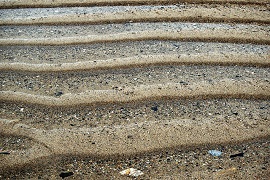Sand
Contents |
[edit] Purpose of Sand In Construction
[edit] Introduction
Sand is a type of naturally occurring material that is of a granular, loose, fragmented composition, consisting of particulate matter such as rock, coral, shells, and so on. Sand is typically finer than gravel but coarser than silt.
The precise composition of sand varies depending on its source and the conditions prevalent at that location. In in-land continental regions, the predominant constituent of sand is silica (silicon dioxide), typically in the form of quartz. Sand that has been created over millions of years by such things as coral and shellfish is typically aragonite, which is a form of calcium carbonate.
[edit] Uses of sand
Sand is very commonly used in construction, often providing bulk, strength, and stability to other materials such as asphalt, concrete, mortar, render, cement, and screed. Sand is also used as a base layer is known as ‘blinding’, which is laid above a layer of hardcore to provide a clean, level, and dry surface for construction works. It can also be used in its raw form as a decorative material in landscaping.
Sand is used in liquid form to manufacture glass and is also used for molding metal casting. It can be used as an abrasive in the process of sandblasting which cleans structural elements, steelwork, and so on. Sandpaper is also made using sand.
[edit] Types of sand
The different classifications of sand are:
- Particle size: 0.6-2 mm (coarse sands), 0.2-0.6 mm. (medium sands), 0.06-0.2 mm (fine sands).
- Particle shape: Angular, subangular, rounded, flat, elongated.
- Texture: Rough, smooth, or polished.
- Composite soil types: Classified as ‘sandy gravel’ or ‘gravelly sand’. Clayey composites are described as plastic or cohesive. Silty composites are described as non-plastic or of low plasticity.
- Structure: Homogenous, inter-stratified, heterogeneous, or weathered.
[edit] Testing
Sand can be tested when batching concrete by volume in what is known as a bulking test. A silt test can be used to measure the cleanliness of a sand sample by establishing the percentage of silt present. This is important as too much silt will weaken concrete. For more information, see Testing sand.
[edit] Related articles on Designing Buildings Wiki
Featured articles and news
Moisture, fire safety and emerging trends in living walls
How wet is your wall?
Current policy explained and newly published consultation by the UK and Welsh Governments.
British architecture 1919–39. Book review.
Conservation of listed prefabs in Moseley.
Energy industry calls for urgent reform.
Heritage staff wellbeing at work survey.
A five minute introduction.
50th Golden anniversary ECA Edmundson apprentice award
Showcasing the very best electrotechnical and engineering services for half a century.
Welsh government consults on HRBs and reg changes
Seeking feedback on a new regulatory regime and a broad range of issues.
CIOB Client Guide (2nd edition) March 2025
Free download covering statutory dutyholder roles under the Building Safety Act and much more.
AI and automation in 3D modelling and spatial design
Can almost half of design development tasks be automated?
Minister quizzed, as responsibility transfers to MHCLG and BSR publishes new building control guidance.
UK environmental regulations reform 2025
Amid wider new approaches to ensure regulators and regulation support growth.
The maintenance challenge of tenements.
BSRIA Statutory Compliance Inspection Checklist
BG80/2025 now significantly updated to include requirements related to important changes in legislation.
Shortlist for the 2025 Roofscape Design Awards
Talent and innovation showcase announcement from the trussed rafter industry.























